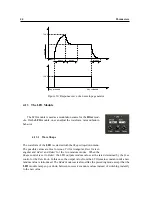
58
Audio and MIDI Settings
6.3
Audio Control Panel
To launch the audio configuration panel, choose Audio Control Panel under Preferences of the
Edit menu on Windows or the String Studio menu on Mac OS systems.
This panel allows you to select the bit depth sample rate (22.05, 44.1, 48, or 96 kHz) and buffer
size, which affects how quickly String Studio responds to the control information it receives. The
smaller the buffer size, the shorter the latency, and vice versa. Note that the content of the dialog
depends on the driver selected in the Audio Settings menu.
Some sound cards provide their own ASIO control panel, in which case the above information
will differ from card to card. Some sound cards also require that you close all programs before
making changes to the buffer size or sampling rate. If you discover this is the case with your sound
card, please refer to the manufacturer’s documentation for details on configuring it for optimum
performance. Most sound card manufacturers also update their drivers regularly. It is strongly
recommended that you visit your sound card manufacturer’s website regularly to ensure you are
using the most up to date drivers and support software.
6.4
Latency Settings
The latency is the time delay between the moment you send a control signal to your computer (for
example when you hit a key on your MIDI keyboard) and the moment when you hear the effect.
Roughly, the latency will be equal to the duration of the buffers used by the application and the
sound card to play audio and MIDI. To calculate the total time required to play a buffer, just divide
the number of samples per buffer by the sampling frequency. For example, 256 samples played
at 48 kHz represent a time of 5.3 ms. Doubling the number of samples and keeping the sampling
frequency constant will double this time while changing the sampling frequency to 96 kHz and
keeping the buffer size constant will reduce the latency to 2.7 ms.
It is of course desirable to have as little latency as possible. String Studio however requires a
certain amount of time to be able to calculate sound samples in a continuous manner. This time
depends on the power of your computer, the preset played, the sampling rate, and the number of
voices of polyphony used. Note that it will literally take twice as much CPU power to process
audio at a sampling rate of 96 kHz as it would to process the same data at 48 kHz, simply because
you need to calculate twice as many samples in the same amount of time.
Depending on your machine you should choose, for a given sampling frequency, the smallest
buffer size that allows you to keep real-time for a reasonable number of voices of polyphony. To
adjust these parameters:
•
Launch the Audio Control Panel
•
Choose the sampling frequency and the audio format (16, 24, 32 bits)
•
Adjust the buffer size
Summary of Contents for STRINGSTUDIO
Page 1: ...USER MANUAL ...



























